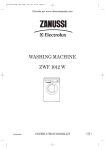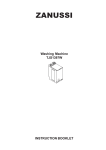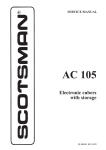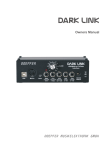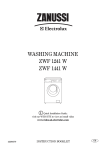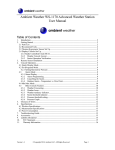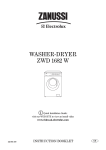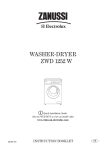Download Zanussi TLE 1116 W Specifications
Transcript
WASHING MACHINE TLE 1116 W 146 4959 01 - 07/06 INSTRUCTIONS MANUAL Contents For the User Important Safety Information 3 Your New Washing Machine 4 Description of the Appliance Detergent Dispenser 5 5 The Control Panel 6-8 Operating Sequence 9-11 Before use 9 Load the laundry 9 Measure out the detergent 9 Add the fabric softener 9 Switch the machine on 9 Select the desired programme/fabric 9 Select the temperature 9 Select the spin speed and the rinse hold option 10 Select the soil level 10 Select the desired options 10 Start the programme 10 How to change a programme during a cycle 10 How to cancel a programme during a cycle 10 How to open the lid during the cycle 11 End of programme 11 Washing Hints Which detergent ? ... And in which form ? Wash Care Symbols Washing programmes Maintenance and Cleaning Descaling After each wash External cleaning Cleaning the detergent dispenser Cleaning the drain filter Maintenance wash The dangers of freezing 17-18 17 17 17 17 17-18 18 18 Something Not Working 19-20 Service and Spare Parts 21 Customer Care Department 21 Guarantee Conditions 22 For the Installer 12-13 13 13 Installation Instructions 23 Technical Specifications Unpacking Positioning Levelling Moving the appliance Water inlet Water drainage Electrical connection 23 24 24 25 25 26 26 27 14 15-16 Guide to use the Instruction Book The following symbols will be found in the text to guide you throughout the instructions: Safety instructions Hints and tips Environmental information 2 Important Safety Information It is most important that this instruction book should be retained with the appliance for future reference. Should the appliance be sold or transferred to another owner, or should you move house and leave the appliance, always ensure that the book is supplied with the appliance in order that the new owner can get to know the functioning of the appliance and the relevant warnings. These warnings have been provided in the interest of safety. You MUST read them carefully before installing or using the appliance. Installation Use This appliance is heavy. Care should be taken when moving it. Always unplug the appliance and turn off the water supply after use. It is dangerous to alter the specifications or attempt to modify this appliance in any way. Do not overload the appliance. See relevant section in the instruction book. All packaging and transit bolts must be removed before use. Serious damage can occur to the product and to property if this is not adhered to. See relevant section in instructions. Only wash fabrics which are designed to be machine washed. If in doubt, consult the care label on the clothes. Before washing, ensure that all pockets are empty and buttons and zips are fastened. Avoid washing frayed or torn articles and treat stains such as paint, ink, rust, and grass before washing. Underwired bras must NOT be machine washed. Any plumbing work required to install this appliance should be carried out by a qualified plumber or competent person. Any electrical work required to install this appliance should be carried out by a qualified electrician or competent person. Any objects such as coins, safety pins, nails, screws, stones or any other hard, sharp material can cause extensive damage and must not be placed into the machine. Care must be taken to ensure that the appliance does not stand on the electrical supply cable. If the machine is situated on a carpeted floor, please adjust the feet in order to allow air to circulate freely. Garments which have been in contact with volatile petroleum products should not be machine washed. If volatile cleaning fluids are used, care should be taken to ensure that the fluid is removed from the garment before placing in the machine. Child Safety Wash small items such as socks, laces, washable belts etc in a washing bag or pillow case as it is possible for such items so slip down between the tub and the inner drum. This appliance is designed to be operated by adults. Children should not be allowed to tamper with the controls or play with the appliance. Pets and children have been known to climb into washing machines. Please check your drum before use. Only use the advised quantities of fabric softener. Damage to the fabric can ensue if you over-fill. Refer to the manufacturer's recommendations of quantities. Keep all packaging well away from children. As some duvets and eiderdowns should be washed in large commercial machines because of their bulk, please check with the manufacturer of the item before washing in a domestic machine. Keep all detergents in a safe place out of children's reach. Under no circumstances should you attempt to repair the machine yourself. Repairs carried out by inexperienced persons may cause injury or serious malfunctioning. Contact your local Zanussi Service Force Centre. Always insist on genuine Zanussi spare parts. 3 Your New Washing Machine Your new washing machine meets all modern requirements for effective treatment of laundry with low water, energy and detergent consumption. Ecological hints In the interest of the environment To save water and energy and help protect the environment, we recommend that you follow these hints: Materials marked with the symbol recyclable. are Check with your local Council or Environmental Health Office to see if there are facilities in your area for re-cycling this appliance. Adjust the quantity of detergent according to the hardness of your water supply, the amount of laundry and the degree of soiling. When the appliance is to be scrapped, cut off the power supply cable and make the door lock device unusable to prevent young children from being trapped inside. A programme without prewash is sufficient for normally soiled laundry. Help to keep your country tidy - use authorised disposal sites for your old appliance. The symbol on the product or on its packaging indicates that this product may not be treated as household waste. Instead it shall be handed over to the applicable collection point for the recycling of electrical and electronic equipment. By ensuring this product is disposed of correctly, you will help prevent potential negative consequences for the environment and human health, which could otherwise be caused by inappropriate waste handling of this product. For more detailed information about recycling of this product, please contact your local city office, your household waste disposal service or the shop where you purchased the product. How do we help to protect the environment? We use recycled paper! Important Your machine is fitted with a balance control device, which ensures the machine is stable during the spin. If the wash load appears not to have been spun sufficiently at the end of the wash cycle, because, it is not evenly distributed in the drum, the balance control device may have operated. It will therefore be necessary to redistribute the wash load manually and select a spin programme. For more detailed information see the section headed "Something Not Working". 4 Description of the Appliance Programme phase indicator lights Programme selection buttons Skip/Reset button Start/pause button Lid Handle for opening lid Lever for castors Trap door for lint filter Detergent Dispenser 1 2 3 4 Detergent compartment for pre-wash . Detergent compartment for main wash . Fabric softener . Softener overflow 1 2 4 5 3 The Control Panel 1 2 3 4 5 6 7 8 9 10 1 ON/OFF button 4 TEMPERATURE button Press this button to switch the washing machine on. Press the ON/OFF button again to switch the machine off. Press this button repeatedly to increase or decrease the temperature, if you want your laundry to be washed at a temperature different from the one proposed by the washing machine. The relevant light will illuminate. Maximum temperatures are - 90°C for cotton, - 60°C for synthetic fabrics, - 40°C for delicate fabrics,wool and fabrics to be hand-wash (HAND WASH programme). 2 MAINS-ON light This light is connected to the ON/OFF button. It lights up when you press the button, and goes out when you press it again. 3 FABRICS button 5 SPIN SPEED button Press this button repeatedly to select the programme on the basis of the type of laundry to be washed. The light relevant to the selected programme will illuminate. The washing machine will propose a temperature and automatically select the maximum spin value provided for the programme you have chosen. You can change these values by operating buttons 4 and 5. You can only select temperatures and spin speeds that are appropriate for the fabric selected. Press this button repeatedly to change the spin speed, if you want your laundry to be spun at a speed different from the one proposed by the washing machine. The relevant light will illuminate. Maximum speeds are - for cotton: 1100 rpm; - for synthetic fabrics, wool and fabrics to be hand-wash: 900 rpm; - for delicate fabrics: 700 rpm. Hand wash When you select this programme, you obtain a particularly delicate washing, suitable for articles of clothing whose label indicates that they must be hand-washed . 6 RINSE HOLD position: when you choose this option, the machine will not drain the water of the last rinse which could crease the laundry. hand-wash. The machine performs 4 rinses instead of 3. At the end of the cycle, the light "END" will light to indicate that the water must be drained. To complete the cycle, choose one of the following options: 8 START/PAUSE button This button has two functions: • Start: after you have selected the desired programme and options, press this button to start the washing machine. The light above the button will stop flashing and remain lit. • Pause: when you press this button again, the programme in progress is interrupted. The light above the button will start flashing. To restart the programme, press the button again. When you PAUSE the cycle, the DOOR light goes out, and it becomes possible to open the lid, provided • the washing machine is not on the heating phase; • the level of the water is not high; • the drum is not turning. • Draining and spin: - Choose a type of laundry with the FABRICS button and then press the SKIP/RESET button once, so as to cause the SPIN light to illuminate (you can also choose the spinning speed by means of button 5), then press the START/ PAUSE button. • Drain only: - Choose a type of laundry with the FABRICS button and then press the SKIP/RESET button once, so as to cause the DRAIN light to illuminate, then press the START/PAUSE button. 6 SOIL LEVEL button Important! You must set the washing machine to PAUSE before you make any change in the programme in progress. NORMAL When selecting a programme, the normal option is proposed by the appliance. However, by pressing the SOIL LEVEL button repeatedly, the soil level can be changed (levels depend on the soiling of the laundry). 9 SKIP/RESET button This button performs two functions: - Clears the memory. - Selects special programmes. At the end of every programme the RESET button must be pressed at least once to clear the programme memory. HEAVY SOIL Suitable for very soiled laundry (only for cotton and synthetic fabrics). By selecting this option, the washing time is increased by 10 minutes. QUICK Suitable for lightly soiled clothes. This function cannot be used on the wool and hand-wash programmes. The washing time is reduced on the basis of the type of FABRICS and TEMPERATURE which have been selected. Selecting a special programme: A wash programme must be selected in the normal way (START button not pressed). A normal wash cycle consists of the following phases WASH - RINSE - SPIN and is confirmed by the illumination of the corresponding LED's. 7 OPTIONS button Press this button to select the following options: PREWASH: select this option if you wish your laundry to be prewashed before the main wash (not available for wool and hand-wash cycle). The prewash ends with a short spin at 650 rpm in programmes for cotton and synthetics fabrics, whereas in the programme for delicate fabrics the water is only drained. EXTRA RINSE: this option can be selected with all programmes except the wool programme and 7 After you have started the programme, only the light relevant to the phase that is currently being carried out will remain lit. To select RINSE and SPIN, press the SKIP button once, the WASH LED goes out. To select SPIN only, press the SKIP button twice. The WASH and RINSE LED's go out. To select DRAIN, press the SKIP button three times, the WASH - RINSE - SPIN LED's go out. If you wish to cancel or advance the running programme to the required phase, PAUSE the cycle and then press the SKIP button as previously described. 10 Programme phase indicator lights When you select a programme, the lights relevant to the phases that form the programme light up. 8 3 Add fabric softener Operating Sequence If required, pour fabric softener into the compartment marked , without exceeding the maximum level. Before use Before using your appliance for the first time, we recommend you to run a 90°C cotton cycle without any laundry, to remove any manufacture residue from the drum and tub: - Pour 1/2 a measure of detergent into the "detergent dispenser" and start the machine. - Select the "90°C cottons" programme. - Press the START/PAUSE button: the wash cycle starts. 4 Switch the machine on Press the ON/OFF button to switch the machine on. The light above the button will light up. 1 Load the laundry 5 Select the desired programme/ fabric Press the FABRICS button repeatedly in order to select the desired programme/fabric. The relevant light will light up. The lights relevant to the phases which form the programme will light up. A • Lift the lid. • Open the drum by pressing the release button (A). The 2 flaps will open automatically. • Shake the laundry out loosely and place into the drum. Close the drum and shut the lid. Warning: before closing the lid of your appliance, ensure that the drum door is properly closed: • The two flaps are fastened. • Button A is released (in the raised position). An electronic system allows the drum to be in the high position when the cycle is finished. This system allows for easier loading and unloading of the laundry. If an unbalanced weight alters the functionning, turn the drum by hand. 6 Select the temperature Press the TEMPERATURE button if you wish to select a temperature value different from the one proposed by the washing machine. The relevant light will illuminate. 2 Measure out the detergent Measure out the amount of detergent recommended by the manufacturer in the main wash compartment . If you are carrying out a pre-wash, pour the detergent into the pre-wash compartment . DO NOT exceed the maximum level. 9 7 Select the spin speed and the RINSE HOLD option 10 Start the programme Press the START/PAUSE button. The relevant light will stop flashing, the DOOR light will illuminate, and only the light relevant to the phase that is in progress will remain lit. Press the SPIN SPEED button repeatedly in order to select the desired spin speed or the RINSE HOLD option. The relevant light will illuminate. If you select the RINSE HOLD option, the machine will stop at the end of the programme with the water still in the tub. 11 How to change a programme during a cycle Before you make any change, you must pause the washing machine by pressing the START/ PAUSE button. It is possible to change any phase before the programme carries out. Changing the type of fabric or temperature is possible, obviously, only during the washing phase. When you make a change to the fabric or temperature, the washing machine will resume the cycle from the beginning. If it is necessary to drain the water in order to change the programme in progress, proceed as follows: • pause the machine by pressing the START/ PAUSE button; • press the SKIP/RESET button repeatedly, until only the DRAIN light remains lit; • press the START/PAUSE button again. You may now select a new programme and press the START/PAUSE button to start it. 8 Select the SOIL LEVEL Press the SOIL LEVEL button if you wish to select an option different from the one proposed by the appliance (NORMAL). You can choose between HEAVY SOIL or QUICK on the basis of the soiling of the laundry level. The relevant light will illuminate. 9 Select the desired options If your laundry is very dirty, it may be advisable to select the PREWASH option. If you wish the laundry to undergo an extra rinse, select the SUPER RINSE option. Press the OPTIONS button so as to cause one or both of the lights to illuminate. 12 How to cancel a programme during a cycle To cancel a programme that is being carried out, press the ON/OFF button to switch the machine off. The light above the button will go out. If it is necessary, carry out a rinse, a spin or a drain. 10 13 How to open the lid during the cycle of the programme We advise you to close the water supply tap and disconnect the plug from the socket. You can open the lid after you have pressed PAUSE, provided the following conditions exist: Leave the lid open in order to air the washing machine. • the appliance is not in the heating phase, • the level of the water is not high, • the drum is not turning. If these requirements are met when you pause the washing machine, the DOOR light goes out and the lid can be opened. Should it not be possible to open the lid, and should it be absolutely necessary to do so, switch the appliance off by pressing the ON/OFF button. After approximately 2 minutes, you can open the lid. Pay attention to the level and temperature of the water in the washing machine! When you close the lid and press the ON/OFF button again, the washing machine will resume the programme from the point where it had been interrupted. 14 End of programme At the end of the programme, the washing machine stops automatically and gives an audible signal (which can be deactivated, see page 7). If you had selected the RINSE HOLD option, the END button is lit to indicate that the water must be drained (page 8). The DOOR light goes out at once. Note: When you switch the machine on, if you need to erase the previously performed programme, it is also sufficient to press the FABRICS button and select a new programme. Press the ON/OFF button to switch the machine off. The relevant light will go out. Remove the laundry from the washing machine. Check whether the drum is completely empty, by rotating it with your hand. The purpose of this is to prevent any items of laundry from remaining accidentally in the drum, where they might get damaged in a subsequent wash (e.g. by shrinking) or bleed colour into another load of laundry. 11 Washing Hints Do NOT overload the machine. Weigh the laundry the first few times you use the appliance. Always: • Empty pockets. The average weights of the most common items are listed below as a guide: • Ensure buttons and zips are fastened. • Consult the care label on the garment. 1000g=1kg 700-1000 g Only wash fabrics which are designed to be machine washed. Pillow case 100-200 g • Place small items such as socks, laces, Tablecloth 400-500 g Sheet Serviette 50-100 g Tea towel 70-120 g Linen hand towel 100-150 g Towelling hand towel 150-250 g Towelling bath towel 700-1000g Bath robe handkerchiefs etc in a washing bag or pillow case, as it is possible for such items to slip down between the tub and the inner drum. Items that should not be put in the machine: • Underwired bras. • Garments which have been in contact with 1000-1500 g volatile or petroleum based products. Man's shirt 200-300 g Apron 150-200 g • Some duvets and eiderdowns should be washed in large commercial machines. Check with the manufacturer of the item. For Best Washing Results: Help the Environment: • Load the laundry loosely alternating large items To save water, energy and help protect the environment. with small ones. • Sort the laundry according to the type of fabric, • Do not use a pre-wash for normally soiled colour fastness and degree of soilage. washing. • White items should not be washed with • Wash full loads. coloured items. • Pre-treat stains and then wash at a lower • Wash new coloured items separately when temperature. washing for the first time. • Only use the advised quantities of detergent • Treat stains such as paint, ink, rust and grass and fabric softener. before washing. • Avoid washing frayed or torn articles. • When washing fabrics requiring different wash temperatures, always select the lowest temperature. 12 Which detergent? ... And in which form? To ensure you obtain the best wash results from your appliance, it is important to use the right detergent in your everyday wash, and only detergents recommended for use in automatic machines. Not only are there different types of detergent, but they are also available in different forms. Whether you choose a powder or liquid in traditional or compact form is down to personal choice. Traditional Powders Pour the powder directly into the dispenser drawer. Do not sprinkle powder onto clothes in the machine drum. To maintain the appearance of your clothes and household textiles and to make them last longer you should use different types of detergent for different washes, whether for whites, colours or delicates. Traditional Liquids Liquid can be placed in the main wash compartment of the detergent drawer marked with the symbol , start the machine immediately upon placing the detergent in the dispenser drawer. Alternatively the detergent is measured into the specially designed dosing device* which should be placed on top of the laundry, and at the back of the machine drum. Whites We recommend the Ariel product range which is biological and designed to provide excellent cleaning and stain removal even at low temperatures. Non Biological If you prefer to use a non biological detergent, which does not contain enzymes we recommend Fairy. Fairy provides good cleaning and stain removal. Compact Powders and Liquids Compact detergents (or concentrates as they are also known) are available in liquid or powder form, and generally require a smaller dosage. Follow the manufacturer's instructions to ensure the most economical usage. Pour the detergent directly into the dispenser drawer, or alternatively measure the detergent into the specially designed dosing device* which should be placed on top of the laundry, and at the back of the machine drum. Coloureds For coloured items you should use a detergent which is designed to clean while maintaining the original colour. Ariel Color does not contain bleach and therefore helps to preserve colours. * if you use a dosing device in a washer dryer, please ensure the dosing device/ball is removed before carrying out a drying programme. Delicate items When washing delicates such as woollens, you should use a product which is specially designed to care for fine fabrics. Dreft Automatic is suitable for woollens and other delicates. Fabric Conditioners These are ideal for improving "softness", and also reduce static cling on synthetics and make ironing easier. They are available in two types. For example Lenor liquid fabric softener, for use in the washing machine/ washer dryer. The liquid fabric softener should be poured into the compartment marked with the symbol . Follow the manufacturer's dosage instructions and never exceed the MAX level. Laundry Bleach For additional stain removal you may wish to use a product such as Ace Gentle Bleach which is used in addition to your chosen detergent. Ace is suitable for all washable fabrics including silks, woollens and coloureds. Bounce conditioning sheets for use in a tumble dryer. We recommend the conditioning sheets are pinned (using a safety pin) to an article of laundry and placed in the tumble dryer. 13 Wash Care Symbols Wash care labels inside garments recommend how to launder your clothes with the best results. The care labelling code is in line with care labelling used in the rest of Europe. The symbols used make it easy to select the correct programme on your washing machine WASHING SYMBOL WASH ACTION FABRIC Normal (Maximum) White Cotton or Linen without Special Finishes Normal (Maximum) Cotton, Linen or Viscose without Special Finishes, Colourfast at 60°C Reduced (Medium) Nylon, Polyester/Cotton, Viscose with Special Finishes, Cotton/Acrylic Mix Normal (Maximum) Cotton, Linen or Viscose, Colourfast at 40°C but not 60°C Reduced (Medium) Acrylics, Acetate, Triacetate, Wool mixes, Polyester/wool Much Reduced (Minimum) Wool, wool mixtures, Silks Hand wash only Do not machine wash BLEACHING Chlorine bleach may be used IRONING Hot Iron Cotton, Linen, Viscose Warm Iron Polyester mixtures, Wool Cool Iron Acrylic, Nylon, Polyester DRY CLEANING May be dry cleaned. Other letters and/or a bar beneath the circle will indicate the required process to the dry cleaner. TUMBLE DRYING May be tumble dried With high heat setting With low heat setting X A cross through any symbol means "DO NOT" 14 Washing Programmes Programmes Programme Type of laundry and Temperature symbols on labels Description of the programme Available options Load Indicative consumptions (*) Energy kWh Water litres Time min. Main wash at 60°- 90°C 3 rinses Long spin SPIN SPEED 4,5 kg RINSE HOLD HEAVY SOIL QUICK PREWASH EXTRA RINSE 2,00 59 140 - 155 Cottons ( ) Coloured cotton: 30°- 60° e.g. shirts, blouses, underwear, towels, household linen Main wash at 30°- 60°C 3 rinses Long spin SPIN SPEED 4,5 kg RINSE HOLD HEAVY SOIL QUICK PREWASH EXTRA RINSE 1,03 54 140 - 155 Synthetics 30°- 60° Synthetics fabrics and blends: e.g. shirts, blouses, underwear Main wash at 30°- 60°C 3 rinses Short spin SPIN SPEED 2,0 kg RINSE HOLD HEAVY SOIL QUICK PREWASH EXTRA RINSE 1,10 52 85 - 100 Delicates 40°- 30° Delicate fabrics: e.g. acrylic fabrics, viscose, polyester, synthetic blends Main wash at 40°- 30°C 3 rinses Short spin SPIN SPEED 2,0 kg RINSE HOLD QUICK PREWASH EXTRA RINSE 0,55 53 65 - 80 Wool Main wash at 40°- 30°C 3 rinses Short spin SPIN SPEED RINSE HOLD 1,0 kg 0,40 50 50 - 65 Main wash at 40°- 30°C 3 rinses Short spin SPIN SPEED RINSE HOLD 2,0 kg 0,40 50 50 - 65 Cottons 60°- 90° Wool 40°- 30° Hand wash 40°- 30° White cotton: e.g. sheets, tableclothes, household linen ( ) This programme at 60°C is the reference programme for the Energy label according to EEC Directive 92/75. (*) The data is given purely as an indication: the consumption values may vary in relation to the quantity and type of laundry, the temperature of the water supply and the ambient temperature. The data refers to the highest temperature provided for each programme. 15 Washing Programmes Special programmes Programme Temperature Type of laundry Description of the programme Rinse Separate rinse cycle for hand washed garments 3 rinses Spin Separate spin for hand washed garments Spin Drain Available options Load Energy kWh Water litres Time min. 0,15 45 40 - 55 - 0,05 - 5 - 20 - 0,01 - 0 - 15 SPIN SPEED 4,5 kg EXTRA RINSE SPIN SPEED For emptying out the last rinse water in programme with the RINSE HOLD option. Indicative consumptions (*) (*) The data is given purely as an indication: the consumption values may vary in relation to the quantity and type of laundry, the temperature of the water supply and the ambient temperature. The data refers to the highest temperature provided for each programme. 16 Maintenance and Cleaning Before carrying out any maintenance or cleaning you must DISCONNECT the appliance from the electricity supply. Descaling The water we normally use contains lime. To help prevent the formation of lime deposits we recommend you periodically, particularly in hard water areas, use a water softening powder in the machine. Do this separately from any laundry and according to the manufacturer's instructions. After each wash Leave the lid and the drum open for a while. This helps to prevent mould and stagnant smells forming inside the appliance. External Cleaning Wipe the exterior cabinet of the appliance with a soft cloth and warm soapy water. Do not use abrasive cleaning products. Cleaning the detergent dispenser fig.1 fig.2 fig.3 fig.4 The detergent dispenser is very easy to remove. Press the pressure tabs located on each side of the detergent dispenser inwards and pull it up (fig.1 and fig.2). Clean the detergent dispenser under running water with a brush or cloth (fig.3). Check that the syphons located at the back of the detergent dispenser are not obstructed (fig.4). Replace the detergent dispenser in the notches until it hangs securely in place (fig.5). Cleaning the drain filter A clean filter is important for correct functioning of the machine, and should therefore be cleaned after every wash. However, if the drain filter is dirty, the FILTER indicator light illuminates. In this case, clean the filter at once. fig.5 Carefully open the door, with a scewdriver for example (fig.6 and fig.7) : fig.6 17 fig.7 To drain the residual water : Place a shallow container beneath the trap door. Turn the filter handle anticlockwise until the filter cap handle is vertical, any residual water will be released (fig.8). To clean the filter : Unscrew the filter anticlockwise and remove (fig.9). Clean the filter carefully under a fast running tap. Replace the filter and refit by screwing in a clockwise direction. Close the trap door. fig.8 Never remove the water drain filter during a wash cycle. Maintenance Wash With the use of low temperature washes it is possible to get a build up of residues inside the drum. We recommend that a maintenance wash be performed on a regular basis. To run a maintenance wash: • The drum should be empty of laundry. • Select the hottest cotton wash programme. • Use a normal measure of detergent, must be a powder (such a Ariel Futur). The dangers of freezing If the machine is exposed to temperatures below 0°C, certain precautions should be taken. • Turn off both the water tap. • Unscrew the inlet hose. • Unhook the drain hose from the rear support and position the end in a bowl. Run the draining programme. To do this: - Switch the machine on. - Select a washing programme. - Press the SKIP/RESET button three times. - Press START/PAUSE button. • Disconnect the appliance. • Screw the inlet hose and reposition the drain hose. • When you intend to start the machine again, make sure that the room temperature is above 0°C. 18 fig.9 Something Not Working Certain problems are due to lack of simple maintenance or oversights, which can be solved easily without calling out an engineer. Before contacting your local Service Force Centre, please carry out the checks listed below. IMPORTANT: if you call out an engineer to a fault listed below, or to repair a fault caused by incorrect use or installation, a charge will be made even if the appliance is under garantee. During machine operation, it is possible that one of the following alarm codes and an audible signal appear: • The light END flashes once : filling problem, • The light END flashes twice: draining problem, • The light END flashes four times : lid opened. • The light END flashes ten times : flaps of the drum door opened SYMPTOM The machine does not start up. The machine does not fill. The machine empties as it fills. The machine does not drain or spin The machine leaks or overfills. POSSIBLE CAUSE SOLUTION The ON/OFF or START/PAUSE buttons have not been pressed. Press the ON/OFF or START/PAUSE buttons. The lid is not properly closed. Close the lid. The appliance is not plugged in. Plug in the appliance. There is no electricity supply from the wall socket. Check the fuse. The main fuse or the fuse in the plug has blown. Change the fuse. The water is not turned on. Turn on the water. The water supply has been cut off. Wait until the water supply is restored. The inlet hose is kinked. Straighten the inlet hose. The water pressure is too low. Consult a qualified plumber. The water inlet filter is clogged. Clean the filter. The end of the drain hose is too low. Position the drain hose at the correct height (between 70 and 100 cm). The end of the drain hose is submerged in water. Re-position the drain hose so it is not submerged. There is no vent in the end of the drain hose. Replace the drain hose. The Rinse Hold option has been selected. Select the SPIN or DRAIN option. The drain filter is clogged. Clean the filter. The drain hose is bent. Straighten the hose. The drainage system pipes are blocked. Consult a plumber. The drain hose extension is incorrect. Consult a plumber. The wash load is unbalanced. Reload the washing and select a SPIN SPEED. Too much detergent. Reduce the quantity of detergent. Unsuitable detergent. Use only detergent for automatic washing machines. The detergent dispenser is blocked. Clean the dispenser. The end of the drain hose is not correctly positioned. Re-position the drain hose. 19 SYMPTOM The machine vibrates or is noisy. POSSIBLE CAUSE SOLUTION The internal packing and/or transit bolts have not been removed. Remove internal packing/transit bolts. The wash load is unevenly distributed. See hints and tips section. The machine is overloaded. Observe the maximum loads quoted for the programme. The lid does not open. The safety device has locked it. Wait 2 minutes until the relevant light has gone out. Unsatisfactory washing results. Too little detergent or unsuitable detergent has been used. Use the right detergent and the right quantity. Stubborn stains have not been treated prior to washing. Treat the stains before washing. The correct washing programme/ temperature has not been selected. Select the correct washing programme/ temperature (see WASHING PROGRAMMES) Too much laundry has been placed in the drum. Observe the maximum loads quoted for the programme. The electronic unbalance detection device has cut in because the laundry is not evenly distributed in the drum. This may happens several times before the unbalance disappears and a normal spinning can resume. If, after 15 minutes, the laundry is still not evenly distributed in the drum, the machine will not spin. In this case, redistribute the load manually and select the spin programme. Spinning starts are late or the machine does not spin. 20 Service and Spare Parts In the event of your appliance requiring service, or if you wish to purchase spare parts, please contact your local Service Force Centre by telephoning: Before calling out an engineer, please ensure you have read the details under the heading "Something Not Working." When you contact the Service Force Centre you will need to give the following details: 1. Your name, address and post code 2.Your telephone number 3. Clear and concise details of the fault 4. The model and serial number of the appliance (found on the rating plate). 5. The purchase date. 08705 929929 Your telephone call will be automatically routed to the Service Force Centre covering your post code area. For the address of your local Service Force Centre and further information about Service Force, please visit the website at www.serviceforce.co.uk. Please note that a valid purchase receipt or guarantee documentation is required for inguarantee service calls. For Customer Service in Ireland please contact us at the address below: Zanussi-Electrolux Electrolux Group (Irl) Ltd Long Mile Road Dublin 12 Republic of Ireland Tel: + 353 1 4090751 Email: [email protected] Customer Care Department For general enquiries concerning your ZanussiElectrolux appliance or for further information on Zanussi-Electrolux products, please contact our Customer Care Department by letter or telephone at the address below or visit our website at www.zanussi-electrolux.co.uk Customer Care Department Zanussi-Electrolux 55-77 High Street Slough Berkshire SL1 1DZ Tel 08705 727727 (*) (*) calls to this number may be recorded for training purposes. 21 Guarantee Conditions Standard guarantee conditions European Guarantee We, Zanussi-Electrolux, undertake that if within 12 months of the date of the purchase this ZANUSSI-ELECTROLUX appliance or any part thereof is proved to be defective by reason only of faulty workmanship or materials, we will, at our option, repair or replace the same FREE OF ANY CHARGE for labour, materials or carriage on condition that: If you should move to another country within Europe then your guarantee moves with you to your new home subject to the following qualifications: The guarantee starts from the date you first purchased your product The guarantee is for the same period and to the same extent for labour and parts as exists in the new country of use for this brand or range of products The appliance has been correctly installed and used only on the electricity supply stated on the rating plate This guarantee relates to you and cannot be transferred to another user The appliance has been used for normal domestic purposes only, and in accordance with the manufacturer's instructions Your new home is within the European Community (EC) or European Free Trade Area The appliance has not been serviced, maintained repaired, taken apart or tampered with by any person not authorised by us The product is installed and used in accordance with our instructions and is only used domestically, i.e. a normal household All service work under this guarantee must be undertaken by a Service Force Centre. The product is installed taking into account regulations in your new country Any appliance or defective part replaced shall come the Company's property. Before you move please contact your nearest Customer Care centre, listed below, to give them details of your new home. They will then ensure that the local Service Organisation is aware of your move and able to look after you and your appliances. This guarantee is in addition to your statutory and other legal rights. Home visits are made between 8.30 am and 5.30 pm Monday to Friday. Visits may be available outside these hours in which case a premium will be charged. France Germany Italy Sweden UK Ireland Exclusions This guarantee does not cover: Damage or calls resulting from transportation, improper use or neglect, the replacement of any light bulbs or removable parts of glass or plastic. Costs incurred for calls to put right an appliance which is improperly installed or calls to appliances outside the United Kingdom. Appliances found to be in use within a commercial environment, plus those which are subject to rental agreements. Products of Zanussi-Electrolux manufacture which are not marketed by Zanussi-Electrolux. 22 Senlis Nurenberg Pordenone Stockholm Slough Dublin +33 (0) 344 62 29 29 +49 (0) 800 234 7378 +39 (0) 0434 39 4700 +46 (0) 8 672 53 90 +44 (0) 1753 219897 +353 (0) 1 4090751 Installation Instructions It is dangerous to alter the specifications or attempt to modify this product in any way. Care must be taken to ensure that the appliance does not stand on the electrical supply cable. Any electrical work required to install this appliance should be carried out by a qualified electrician or competent person. Any plumbing work required to install this appliance should be carried out by a qualified plumber or competent person. Technical Specifications Dimensions Height with panel Height without panel Width Depth Power supply voltage / frequency 895 mm 850 mm 397 mm 600 mm 230 V - 240 V / 50 Hz Total power absorbed 2300 W / (10 A) Heater rating 1950 W Water pressure minimum maximum Maximum load Cotton Synthetics/delicates Wool 0,05 MPa (0,5 bar) 0,8 MPa (8 bar) 4,5 kg 2 kg 1 kg Maximum spinning speed 1100 rpm Electrical consumption (washing at 60°C) 1,03 kWh This appliance complies with the following EC Directive : - 72/23/EEC of 19.02.1973 - Low-Voltage Directive, - 89/336/EEC of 03.05.1989 (including Amendment Directive 92/31/EEC) - EMV Directive. 23 Unpacking Packing used to protect internal parts of the washing machine during transport must be removed before the washing machine is used for the first time. Remove all packing from the washing machine. Tilt the washing machine sideways and then remove the packing under the motor, and straighten the washing machine (fig. 1). Tilt the washing machine backwards, rotate it by a quarter of a turn on one of its corners to remove the transport base (fig. 2). Fig. 1 Fig. 2 Fig 3 Fig 4 Fig 5 Fig 6 Open the washing machine lid and remove the transport packing and plastic films. Close the lid (fig. 3). Use a 10 mm spanner to remove the two screws and spacers at the back (fig. 4). You can now see the openings that must be closed with the plugs in the pack attached to the washing machine; do not forget to fold down the central capsule (fig. 5). Make sure that you have removed all these parts from your washing machine and keep them so that you can use them again if you need them for future transport (fig. 6). If you want to keep your washing machine aligned with the adjacent furniture, you can cut the pipe support strip at the back of your washing machine. Leave the two rectangular side closers in place (fig. 7). Fig 7 Positioning • The installation surface must be clean dry and level. • Do not install on deep pile carpet. • Do not install the appliance in locations where the temperature may fall below freezing. • Please ensure that when the appliance is installed it is easily accessible for the engineer in the event of a breakdown. 24 Levelling the Appliance • The appliance must be levelled using the adjustable feet. • Adjust the feet so that the appliance is level. The appliance must not rock when weight is applied. • Check the appliance is level using a spirit level. Moving the Appliance To move the washing machine, release the wheels by pulling the lever at the bottom of the machine. Pull the lever to the right and move the machine to the required position. When the machine has been correctly positioned, push the lever back to its original position. Do not operate the machine with the wheels released. Warning The machine should NOT be placed on deep pile carpeting. Note Please ensure that when the appliance is installed it is easily accessible for the engineer in the event of a breakdown. 25 Water Connection This appliance is designed to be permanently plumbed into your home's water supply and drainage system. Water Inlet Please install the water inlet hose onto the back of your washing machine : - Insert the seal in the hole at the bottom of the back panel (fig. 1). - Screw on the bottom fitting of the water inlet hose as shown in fig. 2 and fig. 3. - Connect the feed hose connector onto the water inlet tap, taking care to position the gasket correctly. - Turn on the water inlet tap. The water inlet hose cannot be extended. If it is too shor t, please contact the After Sales Department. Water Drainage - Assemble the hose holder onto the drain hose. - Place the assembly in a drainage pipe (or in a sink) at a height between 70 and 100 cm. Make sure that it will not fall out. You must provide an air intake at the end of the drainage hose, to avoid any water being siphoned. Important: the drainage hose must not be extended, on any account. If it is too short, contact a qualified engineer. Drainage onto a sink outlet spigot : If the outlet spigot has not been used before, remove any blanking plug that may be in place. Push the drain hose onto the spigot and secure with a clip if required, ensure a loop is formed in the drain hose (see diagram) to prevent waste from the sink entering the washing machine. The drain hose may be extended to a maximum of 4 metres. An additional drain hose and joining piece is available from your local Service Force Centre. The joining piece must have an internal diameter of 18 mm. Important Before connecting up the machine to new pipework or to pipework that has not been used for some time, run off a reasonable amount of water to flush out any debris that may have collected in the pipes. 26 Electrical Connection Any electrical work required to install this appliance should be carried out by a qualified electrician or competent person. WARNING: THIS APPLIANCE MUST BE EARTHED. The manufacturer declines any liability should these safety measures not be observed. Before switching on, make sure the electricity supply voltage is the same as that indicated on the appliance rating plate. The rating plate is located at the back of the appliance.The appliance is supplied with a 13amp plug supplied, a 13amp ASTA approved (BS1362) fuse must be used. Green and yellow 13A Should the plug need to be replaced for any reason. The wires in the mains lead are coloured in accordance with the following code: Green and Yellow Blue Brown E N : Earth : Neutral : Live Brown The wire coloured green and yellow must be connected to the terminal marked with the letter "E" or by the earth symbol or coloured green and yellow. Blue Cord clamp The wire coloured blue must be connected to the terminal "N" or coloured black. The wire coloured brown must be connected to the terminal marked "L" or coloured red. Upon completion there must be no cut, or stray strands of wire present and the cord clamp must be secure over the outer sheath. WARNING: A cut off plug inserted into a 13 amp socket is a serious safety (shock) hazard. Ensure that the cut off plug is disposed of safety. Permanent connection In the case of a permanent connection it is necessary that you install a double pole switch between the appliance and the electricity supply (mains), with a minimum gap of 3mm between the switch contacts and of a type suitable for the required load in compliance with the current electrical regulations. The switch must not break the yellow and green earth cable at any point. 27 © Electrolux plc 2003




























